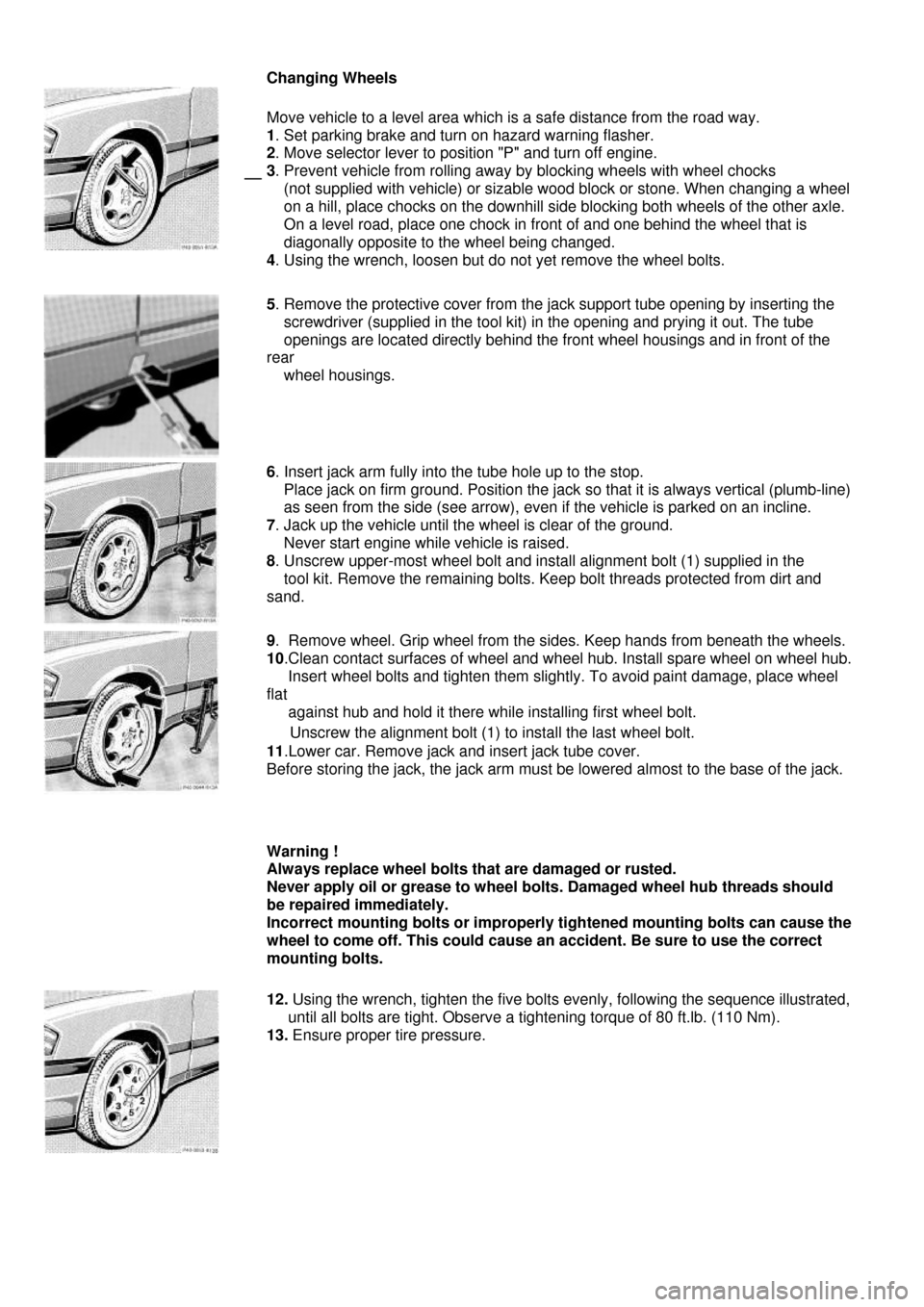light MERCEDES-BENZ C-Class 2000 W202 Owner's Guide
[x] Cancel search | Manufacturer: MERCEDES-BENZ, Model Year: 2000, Model line: C-Class, Model: MERCEDES-BENZ C-Class 2000 W202Pages: 130, PDF Size: 2.43 MB
Page 71 of 130

Cruise Control
Cruise Control
Any given speed above approximately 25 mph (40 km/h) can be maintained with the cruise control by operating the
lever.
1. Accelerate and set:
Lift lever briefly to set speed. Hold lever up to accelerate.
2. Decelerate and set:
Depress lever briefly to set speed. Hold lever down to decelerate.
Normally the vehicle is accelerated to the desired speed with the accelerator. Speed is set by briefly pushing
the lever to position 1 or 2. The accelerator can be released. The speed can be increased (e.g. for passing)
by using the accelerator. After the accelerator is released, the previously set speed will be resumed
automatically. If a set speed is to be increased or decreased slightly, e.g. to adapt to the traffic flow, hold lever in
position 1 or 2 until the desired speed is reached, or briefly tip the lever in the appropriate direction for
increases or decreases in 0.6 mph (1 km/h) increments. When the lever is released, the newly set speed remains.
3. Cancelling
To cancel the cruise control, briefly push lever to position 3.
When you step on the brake pedal or the vehicle speed drops below approx. 25 mph (40 km/h), for example when
driving upgrade, the cruise control will be cancelled. If the cruise control cancels by itself and remains inoperative
until the engine is restarted, have the system checked at your authorized Mercedes-Benz dealer as soon as
possible.
4. Resume
If the lever is briefly pushed to position 4 when driving at a speed exceeding approx. 25 mph (40 km/h), the vehicle
resumes the speed which was set prior to the cancellation of the cruise control. The last memorized speed is
cancelled when the electronic key in the steering lock is turned to position 1 or 0.
Note:
If the engine does not brake the vehicle sufficiently while driving on a downgrade, the speed you set on the cruise
control may be exceeded. In this case the automatic transmission shifts down (max. to 3rd gear) to maintain the set
cruise control speed by using the engine's braking power. As soon as the grade eases, the automatic transmission
shifts up again dependent on the selector lever position. Nevertheless, in some cases you may have to step on the
brake pedal to slow down. In this case the cruise control is switched off. Use the lever to resume the previously set
speed.
Caution !
Moving gear selector lever to position "N" switches the cruise control off.
Warning !
Only use the cruise control if the traffic and weather conditions make it advisable to travel at a steady speed.
• The use of cruise control can be dangerous on winding roads or in heavy traffic because conditions do not
allow safe driving at a steady speed.
• The use of cruise control can be dangerous on slippery roads. Rapid changes in tire adhesion can result
in wheel spin and loss of control.
The "Resume" function should only be operated if the driver is fully aware of the previously set speed and
wishes to resume this particular preset speed.
Page 72 of 130

Charge Indicator Lamp
Should the charge indicator lamp fail to come on prior to starting when the electronic key is in steering lock position 2
or should it fail to go out after starting or during operati on, this indicates a fault which must be repaired at an
authorized Mercedes-Benz dealer immediately.
If the charge indicator lamp comes on while the engine is ru nning, this may indicate that the poly-V-belt has broken.
Should this condition occur, the poly-V-bel t must be replaced before continuing to operate the vehicle. Otherwise, the
engine will overheat due to an inoperative water pump which may result in damage to the engine.
Do not continue to drive the vehicle with the charge indicator lamp illuminated. Doing so could result in serious engine
damage that is not covered by the Mercedes-Benz Limited Warranty.
Low Engine Oil Level Warning Lamp
With the electronic key in steering lock position 2, the o il level warning lamp comes on. It should go out immediately
when the engine is running.
If the warning lamp does not go out after starting the engi ne, or comes on with the engine running and at operating
temperature, the engine oil level has dropped to approximately the minimum mark on the dipstick.
When this occurs, the warning lamp will first come on intermittently and then stay on if the oil level drops further.
If no oil leaks are noted, continue to drive to the nearest service station where the engine oil should be topped to the
"full" mark on the dipstick with an approved oil.
The low engine oil level warning light should not be ignored. Extended driving with the light illuminated could result in
serious engine damage that is not covered by the Mercedes -Benz Limited Warranty. In addition to the warning lamp,
the engine oil level should be periodically checked with t he dipstick (or via the odometer display - Model C280 and
C43 AMG only), for example during a fuel stop, or before a long trip (see Engine Oil Level, Checking in Index)
Page 75 of 130

Low Engine Coolant Level Warning Lamp
With the electronic key in steering lock position 2, the warning lamp comes on.
It should go out when the engine is running. If the warning la mp does not go out after starting the engine, or if it
comes on while driving, then the coolant level has dropped below the required level. If no leaks are noticeable and
the engine temperature does not increase, continue to driv e to the nearest service station and have coolant added to
the coolant system (see Index).
The low engine coolant level warning light should not be ignored. Extended driving with the light illuminated may
cause serious engine damage not covered by the Mercedes-Benz Limited Warranty.
In cases of major or frequent minor coolant loss, have t he cooling system checked at your authorized Mercedes-Benz
dealer as soon as possible.
Note:
Do not drive without coolant in the cooling system. T he engine will overheat causing major engine damage. Monitor
the coolant temperature gauge while driving.
Warning !
Do not spill antifreeze on hot engine parts. Antifreeze contains ethylene glycol which may burn if it comes into contact
with hot engine parts. You can be seriously burned.
Low Windshield and Headlamp Washer System Fluid Level Warning Lamp
With the electronic key in steering lock position 2, the warning lamp comes on. It should go out when the engine is
running. If the warning lamp does not go out after starting the engine, or if it comes on while driving, the level of the
reservoir has dropped to approx.1/4 of the total volume. T he reservoir should be refilled with MB Windshield Washer
Concentrate "S" and water (or commercially available premixed windshield washer solvent/antifreeze, depending on
ambient temperature - see Index) at the next opportunity. The reservoir fo r the windshield and headlamp washer
systems is located in the engine compartment.
Page 76 of 130

Exterior Lamp Failure indicator Lamp
With the electronic key in steering lock position 2, an exterior lamp comes on. It should go out when the engine is
running. If the warning lamp does not go out after starting the engine, or if it comes on while driving, this lamp
indicates a failure in the parking lamp, taillamp, stop la mp, or low beam headlamp. If an exterior lamp fails, the
indicator lamp will come on only when that lamp is switched on. If a brake lamp fails, the lamp failure indicator will
come on when applying the brake and stay on until the engine is turned off.
Note:
If additional lighting equipment is installed (e.g. auxiliary headl amps etc.) be certain to connect into the fuse before
the failure indicator monitoring unit in order to avoid damaging the system.
Brake Pad Wear Indicator Lamp
With the electronic key in steering lock position 2, the brake pad wear indicator lamp comes on .
It goes out when the engine is running.
If the indicator lamp lights up during braking, this indica tes that the brake pads are worn down. Have the brake
system checked at your authorized Mercedes- Benz dealer as soon as possible.
Brake Warning Lamp
With the electronic key in steering lock position 2, the brake warning lamp will come on. It should go out when the
engine is running. The brake warning lamp will come on:
• when there is insufficient brake fluid in the rese rvoir (engine running and parking brake released), or
• when the parking brake is set (engine running).
Warning !
Driving with the brake warning lamp illuminated can result in an accident. Have your brake system checked
immediately if the brake warning lamp stays on. Don't add brake fluid before checking the brake system.
Overfilling the brake fluid reservoir can result in sp illing brake fluid on hot engine parts and the brake fluid
catching fire. You can be seriously burned.
If you find that the minimum mark on the brake fluid reserv oir is reached, have the brake system checked for brake
pad thickness and leaks. To test the brake warning lamp, turn electronic key in steering lock to position 2. The brake
warning lamp comes on, and should go out when the engine is running.
Page 78 of 130

Antilock Brake System (ABS)
Important !
The ABS improves steering control of the vehicle during braking maneuvers. Do not pump the brake pedal, rather use
firm, steady brake pedal pressure. Pu mping the brake pedal defeats the pur pose for ABS and significantly reduces
braking effectiveness.
The ABS prevents the wheels from locking up above a vehicl e speed of approximately 5 mph (8 km/h) independent of
road surface conditions.
At the instant one of the wheels is about to lock up, a slight pulsation can be felt in the brake pedal, indicating that the
ABS is in the regulating mode. Keep firm and steady pressure on the brake pedal while experiencing the pulsation.
On slippery road surfaces, the ABS will re spond even with light brake pedal pressure because of the increased
likelihood of locking wheels. The pulsating brake pedal can be an indication of hazardous road conditions and
functions as a reminder to take extra care while driving.
ABS Control
The ABS malfunction indicator lamp in the instrument cl uster comes on with the electronic key in steering lock
position 2 and should go out when the engine is running.
If the charging voltage falls below 10 volts, the malfunction indicator lamp comes on and the ABS is switched off.
When the voltage is above this value again, the malfunction indicator lamp should go out and the ABS is operational.
With the ABS malfunctioning, the ASR or ESP, if vehicl e so equipped, are also switched off. Both malfunction
indicator lamps come on with the engine running. If the ABS malfunction indicator lamp does not go out or comes on
while driving, it indicates that the ABS has detected a malfunction and has switched off. In this case, the brake
system functions in the usual manner, but without antilock assistance.
Have the system checked at your authorized Mercedes-Benz dealer as soon as possible.
Warning !
ABS cannot prevent the natural laws of physics from acting on the vehicle, nor can it increase the traction
made available by the road conditions. The ABS ca nnot prevent accidents, including those resulting from
excessive speed in turns, following another vehicle too cl osely, or aquaplaning. Only a safe, attentive, and
skillful driver can prevent accidents. The capabilities of an ABS equipped car must never be exploited in a
reckless or dangerous manner which could jeopardize the user's safety or the safety of others.
Note:
To alert following vehicles to slippery road conditions you discover, operate your hazard warning flashers as
appropriate.
Page 85 of 130

Hood
To open:
To unlock the hood, pull release lever (1) under the driver's side of the instrument panel. At the same time handle
(2) will extend out of the radiator grill (it may be necessary to lift the hood up slightly).
Caution !
To avoid damage to the windshield wiper or hood, open the hood only with wiper in the parked position. Pull handle
(2) completely out of radiator grill and open hood (do not pull up on handle).
To close:
Lower hood and let it drop into lock from a height of approx. 1 ft. (30 cm), assisting with hands placed flat on edges
of hood (3). To avoid hood damage, if hood is not fully closed, repeat closing procedure. Do not push down on hood
to attempt to fully close it.
Warning!
To help prevent personal injury, stay clear of moving parts when the hood is open and the engine is running.
Be sure the hood is properly closed before driving. When closing hood, use extreme caution not to catch
hands or fingers. The engine is equipped with a transistorized ignition system. Because of the high voltage it
is dangerous to touch any components (ignition coils, spark plug sockets, diagnostic socket) of the ignition
system
• with the engine running,
• while starting the engine,
• if ignition is "on" and the engine is turned manually.
If you see flames, steam or smoke coming from the engine compartment, or if the coolant temperature
gauge indicates that the engine is overheated, do not open the hood. Move away from vehicle and do not
open the hood until the engine has cooled. If necessary, call a fire department.
Page 93 of 130

Spare Wheel for Model C 43 AMG
The spare wheel rim size is 71/2 J x 17 H2
In the case of a flat tire or breakdown, you may temporarily use a 71/2 J x 17 H 2 instead of the
81/2 J x 17 H 2 wheel rim on the rear axle, when observing the following restrictions:
• Do not exceed vehicle speed of 50 mph (80 km/h).
• Drive to the nearest repair facility to have the flat tire repaired or replaced as appropriate.
For additional information, refer to "Technical Data".
Warning !
The dimensions of the spare wheel are different from those of road wheels. As a result, the
vehicle handling characteristics change when driving with a mounted spare wheel.
The spare wheel should only be used temporarily, and replaced with a regular road
wheel as quickly as possible.
1. Wheel bolt for model
C 43 AMG
2. Wheel bolt for model
C 230 Kompressor and C 280 with light alloy rims
3. Wheel bolt for Canada model
C 230 Kompressor with steel rims
Replace rims or tires with the same designation, manufacturer and type
as shown on the original part. See your authorized Mercedes-Benz
dealer for further information.
Warning !
The jack is designed exclusively for jacking up the vehicle at the jack tubes built into either side
of the vehicle. To help avoid personal injury, use the jack only to lift the vehicle during a wheel
change. Never get beneath the vehicle while it is supported by the jack. Keep hands and feet
away from the area under the lifted vehicle. Always firmly set parking brake and block wheels
before raising vehicle with jack. Do not disengage parking brake while the vehicle is raised. Be
certain that the jack is always vertical when in use, especially on hills. Always try to use the jack
on level surface. Be sure that the jack arm is fully inserted in the jack tube. Always lower the
vehicle onto sufficient capacity jackstands before working under the vehicle.
Page 94 of 130

Changing Wheels
Move vehicle to a level area which is a safe distance from the road way.
1. Set parking brake and turn on hazard warning flasher.
2. Move selector lever to position "P" and turn off engine.
3. Prevent vehicle from rolling away by blocking wheels with wheel chocks
(not supplied with vehicle) or sizable wood block or stone. When changing a wheel
on a hill, place chocks on the downhill side blocking both wheels of the other axle.
On a level road, place one chock in front of and one behind the wheel that is
diagonally opposite to the wheel being changed.
4. Using the wrench, loosen but do not yet remove the wheel bolts.
5. Remove the protective cover from the jack support tube opening by inserting the
screwdriver (supplied in the tool kit) in the opening and prying it out. The tube
openings are located directly behind the front wheel housings and in front of the
rear
wheel housings.
6. Insert jack arm fully into the tube hole up to the stop.
Place jack on firm ground. Position the jack so that it is always vertical (plumb-line)
as seen from the side (see arrow), even if the vehicle is parked on an incline.
7. Jack up the vehicle until the wheel is clear of the ground.
Never start engine while vehicle is raised.
8. Unscrew upper-most wheel bolt and install alignment bolt (1) supplied in the
tool kit. Remove the remaining bolts. Keep bolt threads protected from dirt and
sand.
9. Remove wheel. Grip wheel from the sides. Keep hands from beneath the wheels.
10.Clean contact surfaces of wheel and wheel hub. Install spare wheel on wheel hub.
Insert wheel bolts and tighten them slightly. To avoid paint damage, place wheel
flat
against hub and hold it there while installing first wheel bolt.
Unscrew the alignment bolt (1) to install the last wheel bolt.
11.Lower car. Remove jack and insert jack tube cover.
Before storing the jack, the jack arm must be lowered almost to the base of the jack.
Warning !
Always replace wheel bolts that are damaged or rusted.
Never apply oil or grease to wheel bolts. Damaged wheel hub threads should
be repaired immediately.
Incorrect mounting bolts or improperly tightened mounting bolts can cause the
wheel to come off. This could cause an accident. Be sure to use the correct
mounting bolts.
12. Using the wrench, tighten the five bolts evenly, following the sequence illustrated,
until all bolts are tight. Observe a tightening torque of 80 ft.lb. (110 Nm).
13. Ensure proper tire pressure.
Page 95 of 130

Tire Inflation Pressure
A table (see fuel filler flap) lists the tire inflation pressures specified for Mercedes-Benz recommended tires as well as
for the varying operating conditions.
Important !
Tire pressure changes by approx. 1.5 psi (0.1 bar) per 18°F (10°C) of air temperature change. Keep this in mind
when checking tire pressure inside a garage - especially in the winter.
Example:
If garage temperature = approx. +68°F (+20°C) and ambient te mperature = approx. +32°F (0°C) then the adjusted air
pressure = specified air pressure +3 psi (+0.2 bar).
Tire pressures listed for light loads are minimum values o ffering high driving comfort. Increased inflation pressures for
heavy loads produce favorable handling characteristics with lighter loads arid are perfectly permissible. The ride of
the vehicle, however, will become somewhat harder.
Tire temperature and pressure increase with the vehicle speed. Tire pressure should therefore only be corrected on
cold tires. Correct tire pressure in warm tires only if pressure has dropped below the pressure listed in the table and
the respective operating conditions are taken into consideration.
An underinflated tire due to a slow leak (e.g. due to a
nail in the tire) may cause damage such as tread separation, bulging etc.. Regular tire pressure checks (including the
spare tire) at intervals of no more than 14 days are therefore essential. If a tire constantly loses air, it should be
inspected for damage.
Warning !
Do not overinflate tires. Overinfiating tires can result in sudden deflation (blowout) because they are more
likely to become punctured or damaged by road debris, potholes etc.. Follow recommended inflation
pressures.
Do not overload the tires by exceeding the specified vehicle capacity weight (as indicated by the label on the
driver's door latch post). Overloading the tires can overheat them, possibly causing a blowout.
Page 103 of 130

Jump Starting
Warning !
Failure to follow these directions will cause damage to the electronic components, and can
lead to a battery explosion and severe injury or death. Never lean over batteries while
connecting or jump starting, you might get injure d. Battery fluid contains sulfuric acid. Do
not allow this fluid to come in contact with ey es, skin or clothing. In case it does, immediately
flush affected area with water, and seek medical help if necessary. A battery will also produce
hydrogen gas, which is flammable and very explosive. Keep flames or sparks away from
battery, avoid improper connection of jumper cables, smoking etc.. Read all instructions
before proceeding.
If the battery is discharged, the engine should be start ed with jumper cables and the (12 V) battery of
another vehicle.
The battery is located in the trunk under the trunk floor.
Proceed as follows:
1 . Position the vehicle with the charged battery so that the jumper cables will reach, but never
let the vehicles touch. Make sure the jump er cables do not have loose or missing insulation.
2. On both vehicles:
• Turn off engine and all lights and accessories, except hazard warning flashers or work lights.
• Apply parking brake and shift selector lever to position "P".
Important !
3. Clamp one end of the first jumper cable to the positive (+) terminal of the discharged
battery and the other end to the positive (+ ) terminal of the charged battery. Make sure
the cable clamps do not touch any other metal parts.
4. Clamp one end of the second jumper cable to the grounded negative (-) terminal of the
charged battery and the final connection to the negative (-) terminal of the discharged battery.
Important !
5. Start engine of the vehicle with the charged battery and run at high idle. Make sure the
cables are not on or near pulleys, fans, or other parts that will move when the engine is
started. Allow the discharged battery to charge for a few minutes. Start engine of the
disabled vehicle in the usual manner.
6. After the engine has started, remove jumper cables exactly reversing the above
installation sequence, starting with the last connection made first. When removing each
clamp, make sure that it does not touch any other metal while the other end is still attached.
Important !
A discharged battery can freeze at approx. +14°F (-10°C ). In that case, it must be thawed out before
jumper cables are used. A frozen battery can explode and cause personal injury.
Jumper cable specifications:
• Minimum cable cross-section of 25 mm
2 or approx. 2 AWG
• Maximum length of 11.5 ft. (3.5 m).
Note:
If engine does not run after several unsuccessful starting attempts, have it checked at the nearest
authorized Mercedes-Benz dealer. Excessive unbur ned fuel may damage the catalytic converter.